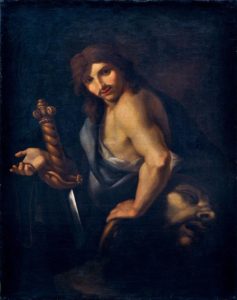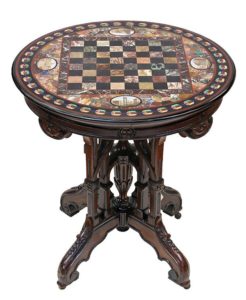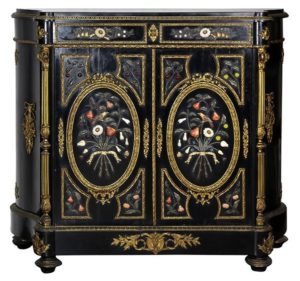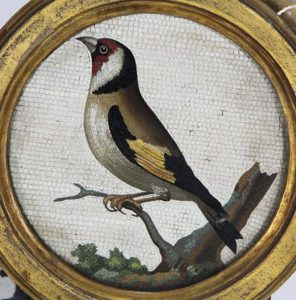
Here is a painting offered at Clars that was most likely collected during the Grand Tour depicting David with the Head of Goliath, that sold for $7,260 in 2010
Recently at auction there has been a resurgence in popularity of items that were acquired during the Grand Tour, including micro mosaics. The Grand Tour spanned a period of 300 years, from the 17th century through the 19th century, and began as a post-study journey of wealthy gentlemen (generally from England) to study art and architecture in Italy and France, and to further enrich their Classical studies. There is an interesting New York Times blog by Matt Gross that further describes the Grand Tour. Gross suggests further reading of “Grand Tours and Cook’s Tours: A History of Leisure Travel, 1750-1915”, by Lynne Withey.
The journey was not an easy one, as the cross-Europe trek began before the Industrial Age, so there were no trains, planes or automobiles (the trek would require a carriage). The gentleman would be accompanied by a French speaking guide, as French was the “lingua franca” at the time. The trip would often begin in Paris, but next would require a journey over the Alps into Northern Italy. This portion of the expedition would often include a visit to Florence and Venice. Next, the traveler would continue to Rome to see the ancient ruins. After the discovery in the mid-18th century of Pomeii and Herculaneum, the trip would often include a visit to these archaeological sites near Naples. An interesting article on the Grand Tour written by Jean Sorabella can be found on the Met Museum website.
Throughout the voyage (which could last anywhere from a few months to several years), visitors often sought to bring souvenirs home with them, or to send mementos to loved ones. The young men would visit galleries and private collections, and were inspired to begin their own collections, both through commissions and by purchasing Renaissance and Old Master paintings. Typically the paintings that were most sought after often depicted Classical scenes, or famous landmarks.
With the Industrial Revolution and the end of the French Revolution, travel in the 19th century became more accessible to a wider audience, including American and English middle class tourists.
Souvenirs that were collected from the late 18th century through the Victorian period included micro-mosaics and jewelry, things that were small enough to wear or transport across the European journey. Often these items depicted Classical architecture or imagery similar to the mosaics found in Pompeii and Ancient Rome. A particularly iconic piece often reproduced is the Doves of Pliny originally found at Hadrian’s villa, now on view at the Capitoline museum.
Micro-mosaics are smaller in size than mosaics and use tiny glass fragments called tesserae. This technique was refined by the Vatican Studio Workshop in Rome in the late 18th century. Initially the studio began production under Pope Gregory XIII to create mosaics at the Vatican Basilica in the 16th century, though the studio did not formally open until the early 18th century. A beautiful piece recently offered at Clars Auction Gallery was a Continental micro mosaic plaque, circa 1790-1800, attributed to G. Raffaelli, depicting an exotic finch that sold for $21,780 in the September 2017 auction. Here is a link to an additional resource to learn more about micro-mosaics.
Another popular form is pietra dura, a technique that utilizes marble, hardstone and semi-previous hardstone. The stone is inlaid to create an image or design. Pietra dura differs from mosaics, in that the pieces are much larger, and are of various sizes. Clars recently offered an American Renaissance Revival games table, circa 1870, having an Italian “Grand Tour” micro mosaics and pietra dura.

American Renaissance Revival games table, circa 1870, having an Italian “Grand Tour” micro mosaics and pietra dura
The souvenirs from the Grand Tour also inspired designers and architects in England. Josiah Wedgwood recognized the significance of the Etruscan urns being brought back to the country. He recognized that there would be a market for reproductions, and began to create Classical style jasperware urns influenced by the influx of Etruscan art. Clars recently sold some fine Josiah Wedgwood urns from the Metropolitan Museum of Art, sold to benefit the acquisitions fund.
Many gentlemen were also inspired by the architecture constructed by Andrea Palladio (1508-1580) to build villas of their own, and considered him to be the embodiment of Classical architecture in the style of the ancient world. Palladian architecture was incredibly popular in England in the 18th century, noted for its Classical style and in stark contrast to the Baroque Period, utilized simplistic decoration. Several well-known homes include the Chiswick House, modeled after Palladio’s Villa Capra, and designed by Richard Boyle, Lord Burlington and William Kent, who also designed Holkham Hall. Stanford University has a database relating to British Architects on the Grand Tour, including over five thousand entries in John Ingamells’ Dictionary on British and Irish Travelers to Italy.

Napoleon III onyx and ormolu mounted cabinet, executed by Charles-Guillaume Diehl, Paris, third quarter 19th century
Also valued amongst collectors are ornately decorated Napoleon III pieces that are executed in the Neo-classical taste. A piece recently offered at Clars Auction Gallery, was a Napoleon III onyx and ormolu mounted cabinet, executed by Charles-Guillaume Diehl, Paris, third quarter 19th century. The case flanked with pilasters having Corinthian capitals, is decorated with hardstone reserves of birds, harken back to earlier styles.
Across the centuries, there has always been an interest in the Classics. Ancient architecture and art has always held a prominent place in history, and continues to enrapture scholars and collectors alike. Hopefully, this fascination will continue for centuries to come.

